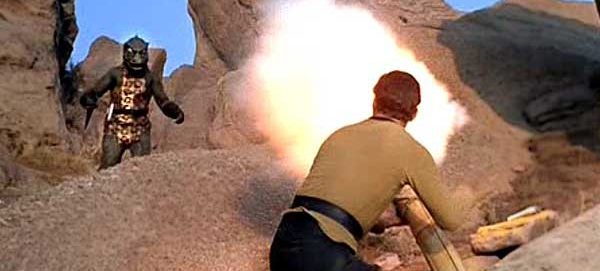If you are a fan of Star Trek – The Original Series, the title picture needs no explanation. If not, I’ll indulge you: In episode 19 ‘Arena’, Captain James T. Kirk is left on a seemingly desolate planet to fight a reptilian enemy known as The Gorn. Both Kirk and The Gorn are weaponless, meaning that the Star Fleet Captain is outmatched by an alien with ten times his strength. Using the planet’s natural resources, The Gorn manufactures a crude blade, while Kirk uses basic chemistry to make black powder.
Last week I stumbled upon a YouTube video where a shooter apparently loaded a black powder muzzle loader with smokeless powder (video below) and I was reminded of Captain Kirk making a crude muzzle-loading canon to defeat the lizard-like Gorn.
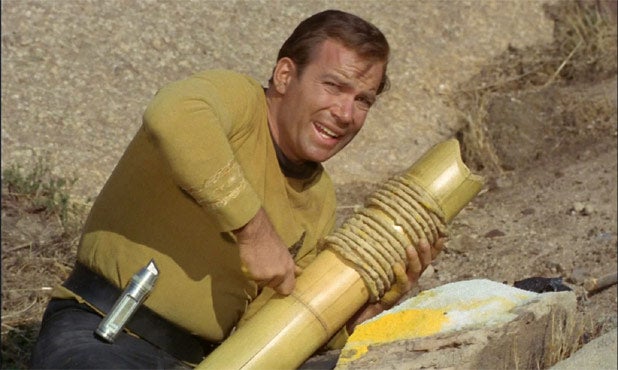
Paramount Television
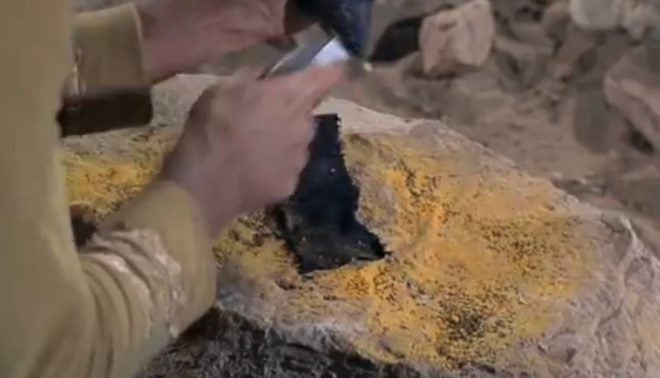
Paramount Television
So, what’s the difference between Black Powder and Smokeless powder? Let’s take a look.
BLACK POWDER:
From CompoundChem.com:
Rather than being one particular compound, gunpowder is actually a mix of three different components. It consists of potassium nitrate (75% by weight), charcoal (15% by weight), and sulfur (10% by weight). Each of these components plays an important role in the combustion of gunpowder.
The precise reactions of gunpowder are difficult to elucidate. Rather than being a simple single reaction, the combustion of gunpowder consists of many differing complex reactions. It’s possible, however, to provide simplified equation that provides an overall idea of the products of the various reactions, as shown in the graphic. A mixture of solid and gaseous products are produced by the reactions, along with a very small amount of water.
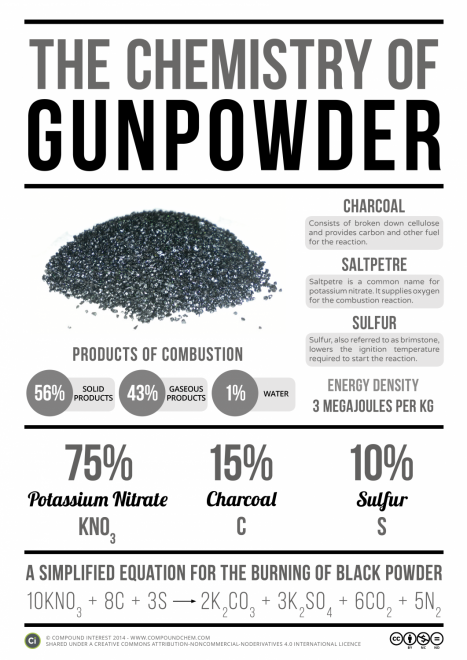
It is important to note that the byproducts of burning black powder are hygroscopic, meaning that they will attract water and thus promote corrosion. Which is why you will see some muzzleloaders washing their guns with soap and water after shooting.
SMOKELESS POWDER:
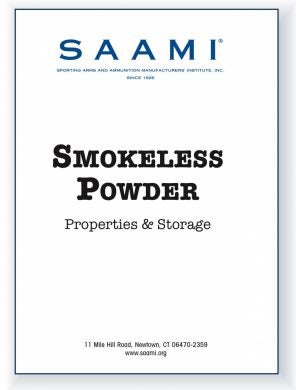
When it burns under pressure, as in a cartridge fired in a gun, smokeless powder produces very little smoke, a small glow and leaves very little or no residue. The burning rate of smokeless powder increases with increased pressure.
Smokeless powder does not detonate like high explosives as it has a controlled rate of burn and differs considerably in its burning characteristics from common “black powder.” Black powder burns at essentially the same rate out in the open (unconfined) as when in a gun.
The basis of the term smokeless is that the combustion products are mainly gaseous, compared to around 55% solid products (mostly potassium carbonate, potassium sulfate, and potassium sulfide) for black powder.[1] Despite its name, smokeless powder is not completely free of smoke;
From Wikipedia:
Smokeless propellant components
The propellant formulations may contain various energetic and auxiliary components:
Propellants:
- Nitrocellulose, an energetic component of most smokeless propellants
- Nitroglycerin, an energetic component of double-base and triple-base formulations
- Nitroguanidine, a component of triple-base formulations
- DINA (bis-nitroxyethylnitramine)
- Fivonite (tetramethylolcyclopentanone tetranitrate)
- DGN (di-ethylene glycol dinitrate)
- Acetyl cellulose
Deterrents, (or moderants), to slow the burning rate:
- Centralites (symmetrical diphenyl urea—primarily diethyl or dimethyl)
- Dibutyl phthalate
- Dinitrotoluene (toxic, carcinogenic, and obsolete)
- Akardite (asymmetrical diphenyl urea)
- ortho-tolyl urethane
- Polyester adipate
- Camphor (obsolete)
- Stabilizers, to prevent or slow down self-decomposition
- Petroleum jelly
- Calcium carbonate
- Magnesium oxide
- Sodium bicarbonate
- beta-naphthol methyl ether
- Amyl alcohol (obsolete)
- Aniline (obsolete)
Decoppering additives, to hinder the buildup of copper residues from the gun barrel rifling:
- Tin metal and compounds (e.g., tin dioxide)
- Bismuth metal and compounds (e.g., bismuth trioxide, bismuth subcarbonate, bismuth nitrate,
- bismuth antimonide); the bismuth compounds are favored as copper dissolves in molten bismuth, forming brittle and easily removable alloy
- Lead foil and lead compounds, phased out due to toxicity
Flash reducers, to reduce the brightness of the muzzle flash (all have a disadvantage: the production of smoke):
- Potassium chloride
- Potassium nitrate
- Potassium sulfate
- Potassium hydrogen tartarate (a byproduct of wine production formerly used by French artillery)
Wear reduction additives, to lower the wear of the gun barrel liners:
- Wax
- Talc
- Titanium dioxide
- Polyurethane jackets over the powder bags, in large guns
- Other additives
- Ethyl acetate, a solvent for manufacture of spherical powder
- Rosin, a surfactant to hold the grain shape of spherical powder
- Graphite, a lubricant to cover the grains and prevent them from sticking together, and to dissipate static electricity
There are three categories of smokeless powder:
Single-Base Powder: Propellants using nitrocellulose (detonation velocity 7,300 m/s (23,950 ft/s)) (typically an ether-alcohol colloid of nitrocellulose) as the sole explosive propellant ingredient.
Double-Base Powder: Propellants mixtures containing nitrocellulose and nitroglycerin (detonation velocity 7,700 m/s (25,260 ft/s)) as explosive propellant ingredients.
Triple-Base Powder: Contains nitrocellulose, nitroglycerin, and a substantial quantity of nitroguanidine (detonation velocity 8,200 m/s (26,900 ft/s)) as explosive propellants.
Over-Simplified Black Powder VS Smokeless Powder Conclusions:
- Black Powder typically burns (deflagrates) rather than detonates like Smokeless Powder
- Smokeless Powder reacts at much higher pressures than Black Powder
- Black Powder byproducts attract water and promote corrosion whereas Smokeless Powder usually includes additives to inhibit corrosion.
- Black Powder is actually a powder whereas Smokeless Powder is normally pelletized extrusions.
- The solid wastes from Black Powder makes the smoke.
- Smokeless Powder isn’t completely smokeless.
- Black Powder and Smokeless Powder are NOT interchangeable.
To prove the last point:
That’s ‘The More You Know’ – Black and Smokeless Powders

 Your Privacy Choices
Your Privacy Choices
